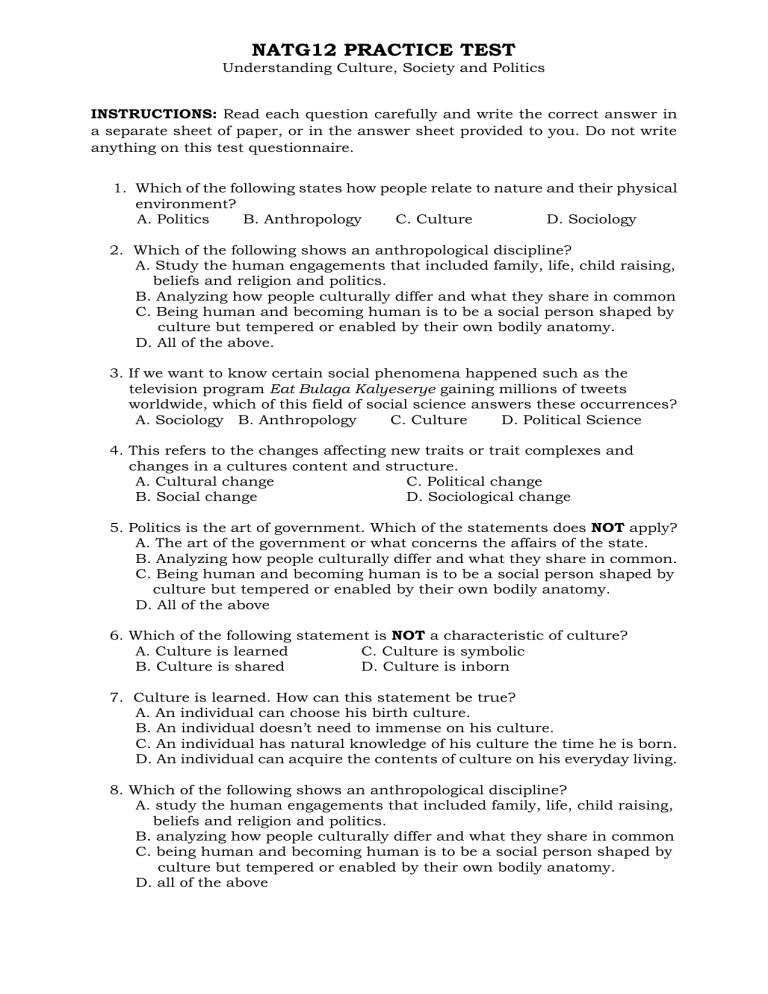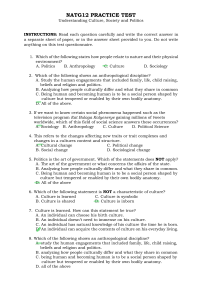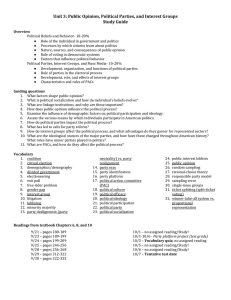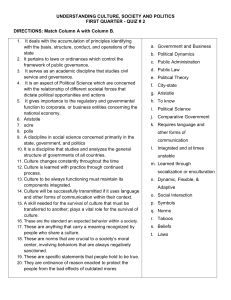
NATG12 PRACTICE TEST Understanding Culture, Society and Politics INSTRUCTIONS: Read each question carefully and write the correct answer in a separate sheet of paper, or in the answer sheet provided to you. Do not write anything on this test questionnaire. 1. Which of the following states how people relate to nature and their physical environment? A. Politics B. Anthropology C. Culture D. Sociology 2. Which of the following shows an anthropological discipline? A. Study the human engagements that included family, life, child raising, beliefs and religion and politics. B. Analyzing how people culturally differ and what they share in common C. Being human and becoming human is to be a social person shaped by culture but tempered or enabled by their own bodily anatomy. D. All of the above. 3. If we want to know certain social phenomena happened such as the television program Eat Bulaga Kalyeserye gaining millions of tweets worldwide, which of this field of social science answers these occurrences? A. Sociology B. Anthropology C. Culture D. Political Science 4. This refers to the changes affecting new traits or trait complexes and changes in a cultures content and structure. A. Cultural change C. Political change B. Social change D. Sociological change 5. Politics is the art of government. Which of the statements does NOT apply? A. The art of the government or what concerns the affairs of the state. B. Analyzing how people culturally differ and what they share in common. C. Being human and becoming human is to be a social person shaped by culture but tempered or enabled by their own bodily anatomy. D. All of the above 6. Which of the following statement is NOT a characteristic of culture? A. Culture is learned C. Culture is symbolic B. Culture is shared D. Culture is inborn 7. Culture is learned. How can this statement be true? A. An individual can choose his birth culture. B. An individual doesn’t need to immense on his culture. C. An individual has natural knowledge of his culture the time he is born. D. An individual can acquire the contents of culture on his everyday living. 8. Which of the following shows an anthropological discipline? A. study the human engagements that included family, life, child raising, beliefs and religion and politics. B. analyzing how people culturally differ and what they share in common C. being human and becoming human is to be a social person shaped by culture but tempered or enabled by their own bodily anatomy. D. all of the above 9. It refers to the actual exposure to another culture and the duration and extent of exposure account for the quality of the results to what? A. acculturation C. transmission B. enculturation D. cultural relativism 10. Which situation below shows an ethnocentric attitude? A. A young Muslim trying to make friends with the Christian neighbors. B. A city boy buying foods of Manobo foods. C. A Christian soldier helping a wounded and dying NPA. D. A Manobo tribe rejecting the products of the Badjao. 11. What refers to a lifelong social experience by which people develop their human potential and learn culture? A. Culture B. Society C. Enculturation D. Socialization 12. What do we call a system of words and symbols used to communicate with other people? A. Symbols B. Norms C. Artifacts D. Language 13. Where can you observed the arena of politics? A. Culture B. Society C. Government D. Anthropology 14. What are the important sources of information in the reconstruction of human evolution? A. artifacts B. fossils C. excavation sites D. All of the above 15. The theory refers to a socialization that may occur between infancy to adolescence. A. Cognitive Development Theory C. Theory of Social Self B. Moral Development Theory D. Psychoanalytic Theory 16. During the hunting and gathering societies, the relationship between men and women are equal. A. True B. False C. Maybe D. None of the above 17. Lisa was a proud cultural relativist. She sees that Ilocanos are thrifty because of their geographical location. Likewise, she sees nothing wrong about it. What did Lisa exhibit in that situation? A. She believes anything goes in one’s own culture. B. She measures behavior by how the other culture regards this practice. C. She has no concept of right or wrong. D. She measures which cultures are related to others. 18. Why is that important to appreciate the different cultures in the society? A. In order to promote peace B. To build cooperation between groups C. To avoid conflict D. All of the above 19. Which of these refers to the structure of relationship which has an interconnection, ties, linkages between people and the larger social institutions like social media? A. Primary Group C. Network Group B. Social Group D. Reference Group 20. Which of these are examples of a network group? A. family B. Fraternity C. favorite sports team D. Facebook and IG 21. Which of these refers to a small, intimate and a less specialized group? A. Primary Group C. Network Group B. Social Group D. Reference Group 22. Which of the following statements Is NOT true? A. Prospective norms are those that define and tell us things not to do. B. Social norms are of different types and norms C. Prescriptive norms are those that define and tell us things to do. D. Society and culture are the same. 23. The state works like a family; it creates agencies to provide for the welfare of its members. Meanwhile, non –state institutions work as ________ to lessen the burden of the state. A. parents C. tito and tita B. brothers and sisters D. lolo and lola 24. Non-state institutions play a very important role in people daily lives. Which non-state institution helps people acquire money or property in order to start a business? A. Banks B. Cooperatives C. Corporations D. Trade unions 25.Which of the following is NOT TRUE about non-state institutions? A. Some are for profit while some are not. B. Some are foreign while some are local. C. They contribute a lot to the economy. D. They do not influence what the government does. 26. Which is the topmost function of education in the society? A. Socialization C. Social Integration B. Social Placement D. Social and Cultural Innovation 27.Which type of education do you think the ALS (Alternative Learning System) students belong? A. Formal Education C. Informal Education B. Special Education D. Non-Formal Education 28. What broad function of education instills values among learners, such as the Filipino traits and values: hospitality, family close ties and ‘utang na loob?’ A. Social B. Political C. Cultural D. Educational 29. If one is born poor yet become successful in life through business, what type of mobility it implies? A. Horizontal mobility C. Stagnant mobility B. Vertical mobility D. Incline mobility 30. Which refers to a system by which a society ranks categories of people in a hierarchy according to social desirables? A. Social inequality C. Social mobility B. Social stratification D. Social class 31. Functionalist perspective on social stratification argues that the more important a position is to society, the more rewards a society attaches to it. Which of the following it applies? A. Rewarding important work with income, prestige and power encourages people to do these jobs and to work better, longer and harder. B. Rewarding fulfilled works with income, prestige and powers do not have an effect to people. C. People do not look for rewards because it is their duty to complete their tasks. D. People always do their jobs because they are paid even if there is no reward. 32. Which of the following is mostly discriminated? A. Poor B. PWD’s C. LGBT D. All of these 33. Which of the following does not portray inequality? A. Discrimination of PWD’s C. Cultural marginalization B. Men are favored in work D. Fair distribution of goods 34. It is a human development measure of the national government that provides conditional cash grants to the poorest of the poor, to improve the health, nutrition and the education of children aged 0-18. A. Education for All (EFA) B. The Philippine Conditional Cash Transfer Program: Pantawid Pamilyang Pilipino Program (4Ps) C. Service Delivery Network (SDN) D. Comprehensive Agrarian Reform Program (CARP) 35. What is a social division that is based on physical attributes? A. Race B. Gender C. Ethnicity D. Differently Able Individual 36. What is a social division that is based on social aspects? A. Race B. Gender C. Ethnicity D. Differently Able Individual 37. How can I call out gender inequality when I see it? A. Speak out about your own experience B. Call out discrimination in the media and advertising C. It’s OK to not challenge discrimination every time you see it D. All of the above 38. Which of this refers to a social, economic and political process that affects those who move, those who stay behind and the places where they go across national boundaries? A. Transnational migration C. International migration B. Overseas migration D. Brain drain 39. Which of these are the primary reason for migration? A. Economic C. Peace and Order B. Political Persecution D. Educational Opportunity 40. Which of the following is NOT a factor for transnational migration? A. Overpopulation C. Transmigrants B. Global Warming D. Wage Disparity 41.What explains that primary education becomes a human right? I. Education is compulsory in the primary level. II. Education is human right since it allows social mobility. III. Education enables the individual to enjoy freedom. IV. Education is for everyone regardless of social status. A. II, III IV B. II and IV C. I only D. I, II, III, IV 42. Ana a 30-year-old female who had just delivered her first child via caesarian section. Fourteen days after her delivery, she suffers fever and mixed emotion feeling. Members of her family conclude that she might be having an illness that is not controlled by science. What could it be? A. Usog (Hex) C. Sumpa (Curse) B. Bughat (Relapse) D. Namaligno (Evil Spirit) 43. What is the aim of social group as a method of social work? A. Development of leadership qualities B. Development of capability for adjustment C. Development of democratic lifestyle D. All of these 44. Jesus Christ, Mahatma Gandhi, Malcolm X, Adolf Hitler and Martin Luther King, Jr. all possessed which type of authority? A. Absolute B. Rational-legal C. Traditional D. Charismatic 45. What do you call a marriage between one woman and more than one man? A. Monogamy B. endogamy C. polygamy D. exogamy 46. Which of the following represents a natural family? A. Parents, children, grandparents, aunts, uncles B. Single-parent family C. Mother, father and their biological children D. Parents and children 47. Mano or Pagmamano is an honoring gesture used in Filipino culture as a way of requesting a blessing from the elders. Why do Filipinos need to do this act of gestures? A. It is a sign of respect to the elders B. It is what they have seen from others C. It is a command from their parents D. They just really appreciate their culture 48. What goal of education desires for a man to become more and more what he is, to become everything that one is capable of becoming? A. Productive B. Manifest C. Self-actualization D. Latent 49. The following are the effect on the evolution of social media in the contemporary societies, which does NOT include? A. It is one way of getting information B. Weathering away our sense of and desire for anonymity and privacy. C. Mobilized in the fight against internet trolls. D. It complicates the way we communicate. 50.Which of these activities in participating governance wherein the power from higher levels are transferred to lower levels? A. Decentralization C. Command and control B. Election D. Collective action Answers Key Understanding Culture, Society and Politics 1. C 2. D 3. A 4. A 5. D 6. D 7. D 8. A 9. A 10. D 11. C 12. D 13. C 14. D 15. A 16. A 17. A 18. D 19. C 20. D 21. A 22. D 23. A 24. A 25. D 26. A 27. D 28. C 29. B 30. B 31. A 32. D 33. D 34. B 35. A 36. C 37. D 38. A 39. A 40. C 41. A 42. B 43. D 44. C 45. C 46. C 47. A 48. C 49. A 50. A




